|
Avian Vet Care in Gilbert AZ
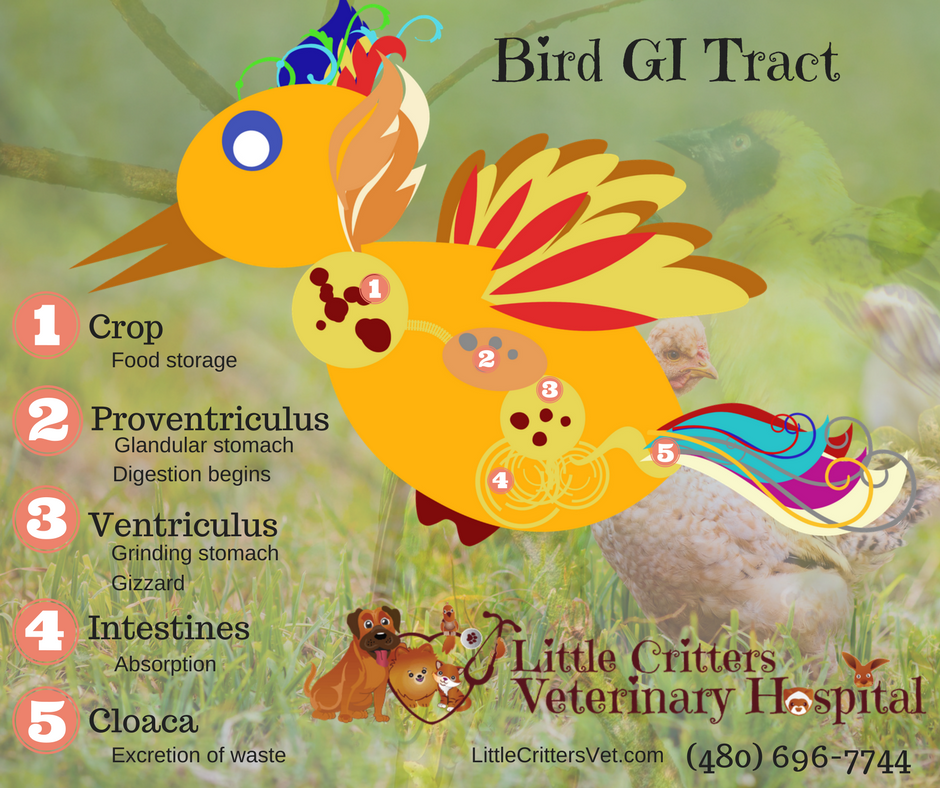
|
BIRD BOOKLET - Avian Care
INTRODUCTION:
Birds are fascinating, beautiful, incredible creatures that I have chosen to share my life with. I’ve enjoyed keeping and raising birds for as long as I can remember and they are greatly responsible for my becoming a veterinarian. While I love these critters, I also understand how difficult they can be to live with & care for properly. Before anyone acquires a pet bird they need to understand what they are getting into. Never acquire any type of pet on an impulse and especially a bird. Studies have proven that birds are much more intelligent than our other commonly kept pets and they also are very long lived. These two factors often contribute to some of the problems we see in avian veterinary medicine. Because birds are so intelligent, they need regular mental and physical stimulation and lack of this commonly leads to behavioral disorders such as feather picking and skin mutilation. Their intelligence can also get them into trouble. As an example, it is not uncommon for a bird to learn that when they scream the owner comes to the cage and they quickly become attention yellers. Also, because they often live for decades on very poor diets, we regularly see diseases associated with severe malnutrition. Therefore, I encourage anyone considering acquiring a bird to become thoroughly educated in the needs of the bird prior to bringing your feathered friend home.
|
|
Veterinarian:
Your avian veterinarian should be one of the most important aspects in providing your bird with a long and healthy life. I highly recommend establishing a relationship with a veterinarian the first day you acquire your new bird. Additionally, all birds should be examined at least yearly by a veterinarian and I recommend regular lab screening as well. The lab screening will vary depending upon what the veterinarian feels is important but typically includes a fecal panel, complete organ panel, and a look at the red and white blood cells. The importance of this cannot be overstated. Birds are notorious for not showing signs of illness until they are critical and a good way to catch them in the early stages of any disease is with basic lab screening. Another benefit of lab screening is for the establishment of normal values for your individual bird. This becomes important when your bird is ill because we have those baseline values to compare the current results to. This allows your veterinarian to determine the longevity of the disease and also helps to allow them to focus on the changes that are of most importance. If I could do only one thing with this web site, it would be to enforce the importance of a good relationship with your veterinarian. Your bird will never get better care then by seeing someone who knows him/her and most importantly knows what is typical for your bird, both in behavior and laboratory results.
Common Behavior Problems:
- Screaming- see behavior tips below – teach your bird to whisper
- Chewing/Destructive Behavior – see toys and caging.
- Biting: Biting can be due to a variety of reasons but a few of the more common reasons are:
|
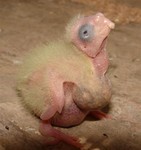
|
Gaining independence:
Many young birds will go through a stage in which they are learning how much force to use with their beaks and also attempting to gain some independence. At this time owners will often get a few bites. I recommend that when the bird bites too hard tell the bird no and place back in the cage. Often this is all you need to do to teach the bird not to bite from the get go. Remember that we are not trying to stop the bird from using its beak – they will often use the beak to grasp your hand while stepping up and to preen us. We are only trying to teach the bird how much force it can use.
Hormonal:
This is a tough one and something I commonly see in Amazons when they reach maturity, but it can occur in all types of birds. Often you will see a loving young bird suddenly turn on the individual who has raised it and pick another family member as their favorite. This is similar to a wild bird leaving its parents and choosing a mate. The best way of dealing with this is to understand that his is a natural behavior and have the family member the bird has picked limit their interaction with your bird, spend time with the bird when that family member is absent, and ensure that only you are the one to provide all favorite treats and activities. The environment can also be altered somewhat to attempt to reduce breeding behavior. Limiting the daylight hours to mimic a winter sun will often help.
Territorial:
This can often be linked to hormonal behavior but typically is the bird that is over protective of its cage and will bite any introduced hand. Firstly, your bird should be taught the up command for the start. In this way the bird is trained to always step onto your hand with this command. Often only letting the bird out of the cage by first having it step up and onto your hand will limit the development of aggression. Some people advocate teaching the bird to step up onto a perch. This can be used but only if the bird is unafraid of the offered perch. Once this bird steps up I recommend taking the bird away from the cage for any further interaction – choosing a neutral territory. Another expression of territoriality can occur as a form of jealousy in which the bird is aggressive to others and sometimes to the owner in the other family member’s presence. This behavior can be improved by encouraging the bird to interact with the other family member(s) for treats and special attention out of the owner’s presence (basically the reverse of a hormonal bird).
|
|
|
Feather Picking & Skin Mutilation:
Feather picking is the most frustrating behavior we have to treat in the veterinary medical field and skin mutilation is the worst manifestation of the behavior. The first and most important thing is to have the bird thoroughly examined by an avian veterinarian. I always recommend to clients to give their bird the benefit of the doubt and first assume it is a medical problem. If medical problems are ruled out then we can safely spend the time needed to work on the behavior. Of course the easiest and best way to treat feather picking is to avoid it in the first place (see the correct beginning below). However, if you already have a feather picker there are some things we can do.
First realize that feather picking has many forms including those listed below in 1-4, following the discussion on types of pickers will be a discussion on some basic changes that may help your bird. Again, the best resource is your avian veterinarian and I always recommend discussing any changes with her/him prior to the implementation:
1) Over preening of feathers:
Over preening is often the first sign of a potential feather picker and can be seen in birds of all ages but I often see this in young birds that have not yet started to pick. Certainly, not all over preeners will go on to pick, but in my experience these birds are at a higher risk of becoming pickers. So what is over preening? My definition is a bird that almost appears obsessed with its feathers and appears to constantly be preening or mouthing its feathers. Of course, preening is a normal activity that is needed for the health of the bird, but the individuals I’m discussing seem to be mouthing their feathers the vast majority of the day and with increased frequency when disturbed by environmental change. Also, the feathers of these birds often look ragged due to this over preening. In my experience these birds are less confident and more prone to emotional upset by any type of change. However, these guys are the lucky ones because if caught at this stage they have a good chance of a normal life in captivity.
|
|
2) Chewing of feathers:
Our feather chewers can be self chewers or can be companion birds that are picking or chewing the feathers of the face and cheeks of their cage mate. For this discussion I’m focusing on the self chewers as another manifestation of picking. Okay, these guys are not necessarily pulling out entire feathers but actually appears to be grooming and while doing so are chewing off parts or all of the feathers. Some of these guys will only have the tips of the feathers chewed as seem by the jagged/irregular edges. The others of this group will actually chew off the entire feather and can chew all feathers on the body or just a select few. The chewed feathers can be identified by the remains of an irregular feather shaft especially on the wings and tail.
|

|
|
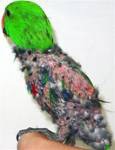
|
3) Plucking out feathers:
The feather plucker is the most common type we see in practice. These guys will vary from the bird that just plucks a few coverts exposing the fluffy underlying gray down feathers (often over the top of the wings) to the bird that has plucked its entire body. Please note that pluckers cannot pluck out head feathers so if a bird is also missing head feather (and doesn’t have a cage mate that may be plucking) the bird is likely losing feathers from another cause such as PBFD virus. So, the typical whole body plucker has few to no feathers on the entire body, except the head which is usually in perfect feather. Often we see these birds after they have been plucking for an extended period of time or have seen several other veterinarians. Again, realize that it is best to start treatment early with all feather pickers and to do a complete laboratory health work-up first.
|
|
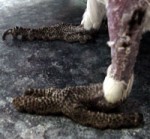
|
4) Chewing on skin to create wounds:
Not all feathers chewers or pluckers will go on to actual skin mutilation, but this manifestation if the most dangerous for the individual bird. These birds will also pluck feathers, but will go on to actual chewing/tearing of the skin. Areas targeted can vary but often I see injury/scabs on the keel or feet and legs. The injuries can vary from mild superficial skin wounds to life threatening injuries. I consider this an emergency problem for the bird and thus it must be addressed immediately. I’m not a big fan of placing birds in e-collars (cones that look like lamp shades and placed around the neck to prevent access to the body) but often time these guys have to be collared to prevent ongoing injury. If an e-collar is used it is extremely important to work on correcting any underlying medical and/or behavioral issues. The e-collar should not be used as the correction to the problem and the bird should not be made to live its life in the collar.
|
|
|
ENVIRONMENTAL CHANGES AND SOME TREATMENTS:
The most important thing to remember when treating a feather picking or chewing bird is that this is often a lifelong management issue and there is no quick fix or cure. Therefore, it is important to realize that correcting this problem may take a considerable amount of time and commitment. Also, the longer the behavior has persisted the more difficult it is to correct. It is always best to take the bird to your veterinarian as soon a behavior is noticed. The birds caught early have the best chance of success in reducing or eliminating the negative behavior. That said, the following are some environmental changes I often suggest after a complete health screen of the bird. (for caging and housing see correct beginning)
|
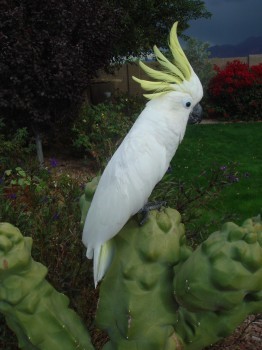
|
1) Full Spectrum Lighting:
Often our birds are completely housed indoors and never see the sunlight. Even those by a window will not benefit from the sun because the window acts as a filter preventing the bird from absorbing the benefits of the sun such as Vitamin D3. Birds use the sunlight by preening their feathers with feather dust in the case of cockatiel or cockatoos or the oily secretions of the uropygial (preen) gland. The substance on the feathers will undergo a chemical reaction from the sunlight producing Vitamin D3 which the bird ingests with further preening of the feathers. The exclusively indoor bird does not have the benefit of the reaction. One alternative is to provide full spectrum lighting. The packaging for the light should state that is provides both UVA and UVB rays and must always be a fluorescent light and not an incandescent bulb. The introduction of the light should be slow to prevent stress to the bird. I’d suggest starting out with the light in the same room but not lighted or next to the cage and gradually moving it closer to the cage over several days. When the bird appears comfortable with the light is can be placed within 18inches of the cage and turned on. Ensure that the bird is unable to access the light or cord because most will chew given the opportunity. Also, the light should not be left on around the clock. Night time and darkness is also important to the bird’s health and I recommend 12 hours of uninterrupted darkness each night. Some of the better light will simulate dawn and dusk with a slow brightening and dimming and can be placed on a timer for consistency. Another option is to provide an outdoor cage for temporary sunning. The cause must have shaded areas available at all times and should be protected from wild birds or their droppings.
|
2) Humidity:
Many of our captive birds are adapted to the jungle and very high humidity. I suggest you research the natural lifestyle of your particular species and attempt to provide something close to their natural temperature and humidity. Often we live in areas of the country with very low humidity (i.e. Arizona) or we live in areas that require artificial heating which will lower the humidity. Either of these situations can be uncomfortable for our birds. Feather pickers will often benefit from increased humidity because it is soothing to the skin and allows them to keep their feathers clean. A great way of increasing the humidity is to provide a daily bath for your bird. Bathing can be done in a variety of way depending on the individual. Many of the larger parrots enjoy showering with us and there are actual shower perches that can be purchased. Smaller birds may enjoy misting or a shallow bowl of fresh clean water placed in the cage daily. Noise will often stimulate bathing activity and my birds will almost always bathe when I run the vacuum. For smaller birds I’ve also run the skin faucet slowly and placed the bird on a towel over the skin divider (for traction). The birds will watch you running your hands under the water and often will join in on the activity. Bathing with water alone will improve the health of the skin and feathers, but for feather pickers I’ve often added a prescription shampoo to the bathing routine (especially for the shower birds) and this is often an effective way of treating secondary skin infection caused by the trauma of picking. Of course you should never use an over the counter shampoo and also check with your vet prior to using any substance on the skin or feather. Often time anti-pick sprays will often increase the feather destruction because the bird is attempting to clean the substance off its feathers. So always check with your vet first. A humidifier is another means of increasing the humidity. If used, the water chamber must be cleaned in the dishwasher every day to prevent growth of fungus and bacteria that can be very harmful to our birds. Also the paper or cage litter must be changed daily to prevent growth of fungus and of course the bowls should always be cleaned daily as well.
|
|
3) Provide mental stimulation during the day:
I cannot over stress the importance of this need. Our birds are often left sitting alone in the cage, with a dish full of food, while we are at work. These can be long boring hours for our intelligent companions. They have no interaction with other intelligent beings most of the day, there is no work involved in getting food and there is no ability for vigorous exercise during the day. Why wouldn’t they feather picking. In the wild these same birds would spend their time interacting with flock mates, flying to distant locations while expending lots of excess energy, and most importantly looking for food throughout the day (mental stimulation). So what can we do? Toys, toys, toys… Think of a child spending time in a room alone and then the same child in a room full of enriching/interactive type toys. Still not perfect but better. I always suggest a variety of toys (see links below) that should include hand toys, puzzler toys, treasure chests, chewable toys and foraging toys. Think of toys not as an option or luxury for the pet bird, but as essentials to that bird’s well being. Please review the excellent links that are provided at the bottom of the page as well as the article on foraging shown below. I also suggest placing a TV or radio on a timer so that it repeatedly goes on and off through the day. This will still allow the bird some quiet time while also providing mental stimulation. Placing the cage in partial view of a window is also helpful. And requiring them to forage for their food is excellent mental stimulation. Foraging may involve hiding food or placing food in toys that they must "unlock" to get the treats (see foraging article below).
|
4) Vary the location of the cage or have multiple cages:
Caution should be used especially in a timid bird with little self confidence. Some birds are so frightened of change that a cage move will cause picking (see correct beginning). However, if your bird is already picking providing variety in the cage location may give them other things to think about and provide some distraction to slow the picking. Of course, it is best to start out early with a baby bird but even older birds can lean to tolerate change if the introduction is gradual.
5) A companion bird????
This is a tough question and can go either way depending on the individual bird. Ideally, I recommend when purchasing a baby bird that 2 birds be purchased. I believe it is unfair to these intelligent beings to require that they spend their lives alone. If raised together many birds will become lifelong companions. The babies should both be hand fed so that they are very tame and you must interact frequently with both birds to keep them tame and loving with the family members. The down side of having 2 birds is that they can become aggressive with each other (especially if introduced later in life) and breeding activity can be stimulated. Breeding activity or hormonal changes can occur with 2 birds of the same sex of even with a single bird that has a mirror. The negative aspects of these hormonal changes are potential aggression, feather picking due to hormonal stress, and reproductive problems such as egg binding in females. If a bird has lived the majority of its live alone and has behavioral problems such as feather picking I often do not recommend getting a second bird. The original bird is often very jealous of the newcomer and fighting may ensue, also the new bird may develop the same behavioral problems as the first. It is best to work exclusively on the original bird to improve its general health both mental and physical.
|
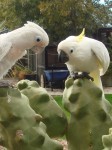
|
6) Caging:
Don’t have your bird in the kitchen or in the center of activity but rather on the periphery of activity so that they can be a part of the family but can also "escape" for some quiet time.
7) Toys and perches:
see behavior tips and links below…
|
|
8) Nutrition – General Recommendation:
The feather picker is causing damage to its skin and feather follicles which can lead to secondary infection. It is important to provide the best possible nutrition for your particular species of bird to allow for a healthy immune system and prevent the stress of vitamin and nutrient deficiency. Realize that all birds are not the same and cannot eat the same diet. Ideally, I like to offer a variety of foods that include a organic and color free avian pellet, a large variety of fresh veggies, and a small percent of fresh fruits and seeds. The following are a few dietary generalization on some individual species, but again it is important that you speak with your veterinarian and do research on your bird prior to making any changes.
In general you need to provide a large variety of fresh food for your bird. Typically I recommend a core diet of an organic and color free parrot pellet. A large variety of fresh vegetables should be provided for both nutrition and mental stimulation. A small amount of seeds can be provided as a treat. Seeds should be clean and fresh. Sprouted seeds can also be offered and are a good way of introducing greens to the stubborn eater.
- Macaws: Variety will occur with the individual types of macaws. However, in general these birds require a higher fat content in their diet which can be provided with some of the large nuts as a part of their regular diet.
- African Greys: Greys are often subject to calcium deficiency and will require higher calcium content in their diet then other birds. The best way to provide this is by providing calcium rich foods such as cheeses and yogurt in moderation. Greens such as collards, kale, and mustard greens provide a healthy source of calcium. Another source is from almonds and dairy products in moderation.
- Eclectus: Ares often require more vitamin A in their diet than other birds, but you must be very careful with supplements because it is easy to create Vitamin A toxicity. Again, providing natural sources of Vitamin A is best. Feed dark leafy green and yellow veggies daily. Sweet potatoes, squash and bell peppers are a good source of Vitamin A that many birds enjoy.
- Small Birds: Budgies & Cockatiels: These guys are my exception to the rule of pellets. In general I like to place my avian patients on a complete balanced pellet, but for budgies and cockatiels I recommend that the pellets be no more than 50% of their diet with fresh/clean seeds offered daily and of course fresh veggies.
|
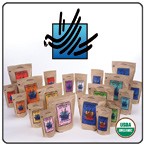
|
Foods to Feed Only in Moderation:
- Those veggies containing a high amount of oxalates. Some common examples include: spinach, chard, and bok choy.
- Fruits, which can provide too much sugar in the bird’s diet.
- Diets that are based 100% on cooked beans/grains/pasta. These diets often have too much phosphorus and are very high in calories which can result in an obese bird.
- The diet should not be based on seeds. Seed diets contain too much fat and are deficient in many nutrients.
Foods to NEVER Feed:
- Caffeine
- Chocolate
- The pits of most fruits – i.e. Avocado
- High acid foods such as tomatoes and pineapple (uncooked)
9) Medical Options:
Certainly treatment of any primary or secondary medical causes of feather picking will need to be treated by your veterinarian. Many of these birds will develop secondary fungal and bacterial infections from the chronic skin damage. Also, many illnesses will cause picking and these will be discovered based on a physical and laboratory examination. Each illness will have its own treatment based on how it is affecting the bird.
A couple of things that I don’t recommend for routine use in feather picking birds are
- Medroxyprogesterone acetate (Depo-Provera) which can cause obesity and liver disease
- Steroid injections which potentially can cause liver and gastrointestinal disease.
|
|
Medications for anxiety
It is important to remember that a medication is not a quick fix for this very complicated problem and is not warranted in all cases. You must first have a complete physical and laboratory examination of your bird and then work on correcting any environmental concerns. The best use I’ve had for medications are in those birds who are long term picker, very nervous birds, and birds causing skin damage. Also, remember that none of these drugs are had formal studies done in birds and are not labeled or approved for this use. Some medical options may include:
- Clomipramine: This drug is labeled and used for dog separation anxiety.
- Haloperidol: An antipsychotic drug that can have liver side effects
- Fluoxetine: Prozac, selective serotonin reuptake inhibitor
- Amitriptyline: often used in cats for elimination problems, tricyclic antidepressant
Medications for hormonal feather picking:
Some birds will be greatly influenced by hormonal changes and this stress will cause feather picking. It is best to first make environmental changes such as removing mirrors or nest boxes (this can include anything the birds thinks of as a nest box), preventing hormonal stimulation such as petting that induces this behavior, and altering the light cycle to mimic winter sunlight. If all these changes fail than drug therapy may be warranted. Drug therapy is most effective in females but has also be tried in males.
- Lupron: leuprolide acetate has an inhibitory effect on the pituitary that should reduce the hormones FSH and LH. This drug has been used in birds for chronic egg laying, hormonal aggression and feather picking. Again, this is not a perfect drug and certainly not for all situations.
Antihistamines for Allergies and itchy skin:
Most feather pickers are NOT allergic birds and are not picking due to itchy skin, but there are exceptions and some birds will benefit from antihistamines. For those birds that do have allergies or skin irritations it is important to reduce environmental causes such as cigarette smoke in the air or on your hands, perfumes or other aerosolized sprays, and dust from cockatoos which can cause allergies in birds such as macaws. Always have clean hands when holding your bird, don’t use any sprays around the bird and ensure that the room is well ventilated.
- Diphenhydramine: both oral and topical forms
- Hydroxyzine: both oral (liquid) and topical
|
|
Behavior Tips:
|
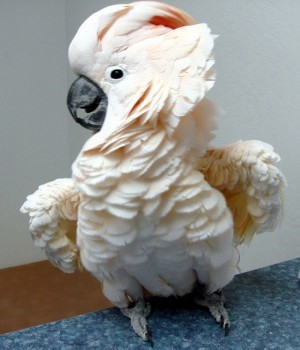
|
The correct Beginning:
When starting with a baby bird (chick) it is extremely important to interact with the baby, as you will be doing throughout its life. This means that you spend the time with the cute little baby that you will have to spend with the adult bird. Many behavior problems are thought to arise from a well-meaning owner spending every minute of his/her spare time with their new adorable baby and allowing them to rule the house. Problems arise when the bird becomes an adult and suddenly is no longer the center of attention.
Routine:
I encourage my clients to start from the first day by establishing a routine for their interaction with their new bird. This should be a routine with which they will be able to follow throughout the bird’s life. For instance, I recommend not rushing to the bird’s cage the instant you come home because this teaches the bird to expect immediate attention every time you walk in the door. You want the bird to be comfortable both with and without your constant presence. A well-adjusted bird will play happily in its cage as well as with you.
Also, start from the beginning by introducing new objects into their environment such as toys and exposing them to new people and situations. This helps to desensitize the bird to change later in life.
|
To fly or not to fly:
Some avian experts believe that in order for a chick to grow into a confidant adult they need to learn to fly. Flying not only builds muscle, but the bird also learns to navigate and seems to promote balance and the development of confidence. This method utilized a delayed wing trim on young birds. The bird is allowed to fledge out and learn to fly. I recommend teaching your bird to come to you on cue at this point or you’ll be forever retrieving them form topmost areas of your house. Once the bird has gained a good flying ability the outer few primary wing feathers are gradually clipped until the bird is no longer able to gain lift. I do believe that this result in a better emotionally developed bird, but if you decide to utilize this method of raising your bird you must understand the inherent danger. Young birds will have no navigation ability and will fly into walls and windows to they should only be allowed to fly in a "safe" room and they should be kept out of kitchens and bathrooms – full of dangers to the young flier. Of course, the primary danger is that your bird could escape the house and be forever lost. For that reason, I don’t recommend this method is young children are in the house (it is just about impossible to always watch for the open doors). And this is another reason the bird should be taught to fly to you on command early in life, but realize that a scarred young bird that escapes the house may be long gone before you can call the baby back.
Enrich the environment:
Because we want our birds to be content in their cage during the times that we cannot interact with them, it is important that the cage be a fun place to be and not a prison. Enriching the environment means providing distractions for your bird in many different ways.
|
|
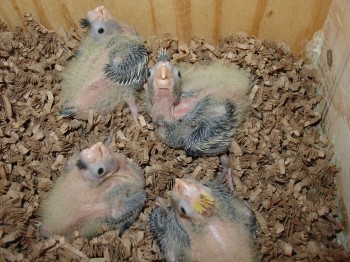
|
Toys:
Toys are an essential part of your bird’s life. I recommend keeping a toy box and rotating through several toys on a weekly basis to prevent boredom. Of course the toys must be bird safe. This means that they must have lead and zinc free paint and not have areas where the bird can get toes or tongue entrapped. Birds can hang themselves so the diameter of rings is important and should be either too small to allow a head through or very large to prevent entrapment. The type of material used in the toys is also noteworthy. The new acrylic toys are pretty and last forever, but aren’t always the best choice. Birds are chewers by nature and should have toys that they can demolish. I like the new wood toy boxes that are available at the national chain pet stores. These boxes have various shaped wood toys stained with vegetable dyes. The advantage is not only the chew ability, but also the ability of the bird to pick up the toy and hold it. These types of toys often prove satisfying to cockatoos that like to demolish their perches. Other toys I’ve found useful for our intelligent friends are the toys that the birds have to learn to use. These are toys built so that the bird has to do something to get to a treat or to make the object move. The more "mechanical" driven birds that like to find new ways of opening their cage door often love this type of toy.
Older birds that have not been exposed to any variety in their lives may originally be frightened by the introduction of toys. The best way to get around this is to do a very gradual introduction. I like to start by just placing the object in the room and gradually moving it closer to the cage until the bird is accustomed enough to allow introduction into the cage. The most important thing is to not give up. These older birds will benefit from environmental enrichment just as much as the babies.
|
Perches:
Birds require a variety in size, shape and texture of perches. Birds rest their feet by changing what they are perching on and those individuals that are not allowed variety are often subject to foot sores. The hardwood perches are virtually indestructible but should not be the only type of perch. If you have unsprayed trees in your yard, a few dried natural branches are often the best choice. Having one cement perch in the cage allows the bird to polish its beak by rubbing the beak on the perch to remove the outer dead layer of cells. Another good choice is a rope perch. I especially like these perches for the new clumsy baby birds such as Amazons and African Greys, because they allow the bird to get a good grip on the perch. Caution should be used with these perches though because if chewed on strings can be released that can entrap a birds foot. Throw out the chewed on rope perch. So, the most important thing is to provide your bird with a variety of perches to keep your friend happy and healthy.
Location of Cage:
As I stated, I believe it is important to get a baby used to change so that they don’t become an adult bird that suddenly plucks out all its feathers when they cage is moved. Having said that, there are some dos and don’ts regarding the placement of the cage.
DON’T:
- Place the cage directly in front of a window, which is subject to dramatic temperature shifts and also doesn’t allow the bird to escape the view.
- Place the cage directly in line with a heat or ac vent
- Place the cage in a kitchens or bathroom. Kitchens have large variations in temperature and toxins can be inhaled from non-stick cookware and from self-cleaning ovens. If kept in a bathroom the bird is likely to be exposed to aerosolized products that can also be irritating and toxic to their air sacs.
- Place the cage in the center of activity for the house. This can result in a stressed and sleep deprived bird.
DO:
- Place the cage in an area of the house where the bird can see and interact with the family.
- Place the cage in an area with a partial view out a window so that bird can escape from unwanted/frightening views.
|
Further Caging Options:
I like to have a night cage in another room. This allows the bird to be placed in the sleep cage at the same time nightly, preventing sleep deprivation.
Ideally, the room should be one that is quiet and dark after dusk.
In warm areas of the US it is also nice to have a sun cage for your bird. This is an outdoor enclosure where your bird can be safely placed on nice days to allow further environmental stimulation and sunbathing. The enclosure should have a solid roof to prevent contact with wild bird droppings and should have at least one shady area.
Please realize that my discussion involved how to make the cage an enjoyable and safe place for your bird and it did NOT give the option of not using a cage. All birds should be caged when you are not able to directly supervise them. An unsupervised bird will chew anything in reach (even items containing toxins such as lead and zinc), will roam the house and can be stepped on or injured by other family members and pets, and will ingest items that are unsafe. Remember, our goal is to make the care a happy and safe place for your pet. Allowing a bird to roam the house is like allowing a toddler to roam unsupervised, it can only lead to problems.
|
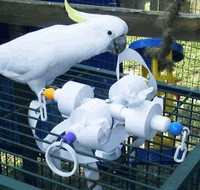
|
|
|
Teach your bird to whisper:
Screamers are made and not born
Birds quickly learn that we respond when they yell which results in one of the most common behavior problems – the bird that screams incessantly. The best way to deal with this is to use your birds intelligence to your advantage.
Never respond when the bird is yelling. This means do not talk to them, don’t look at them and certainly don’t go to their cage. I recommend leaving the room if the bird starts to scream inappropriately.
Reward the bird for good behavior. Pick a vocalization that your bird already makes and encourage it. Most birds have a variety of vocalizations that they make throughout the day even if they don’t actually speak. Pick one of these and EVERY time the bird repeats this vocalization in your presence reward the bird. Rewards can vary depending on the individual, but common ones include food rewards, toy rewards and the best is to be taken out of the cage for a cuddle.
Realize that some screaming is normal for birds and cannot be totally eliminated. Most birds will vocalize at dusk and dawn and an occasional vocalization should be accepted as a part of a healthy well-adjusted bird’s normal behavior. We just want to eliminate the inappropriate behaviors only.
|
|
TEACH YOUR BIRDS TO FORAGE & HELP AVOID FEATHER DESTRUCTIVE BEHAVIORS
The following is an article I authored for a local paper and has more extensive information on foraging than what is scattered throughout the rest of this page. I hope it proves useful to the readers.
|
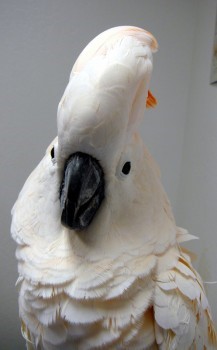
|
IS FEATHER PICKING A MEDICAL OR BEHAVIOR PROBLEM?
Often it is both. Without a doubt feather destructive behavior (FDB) is the most common problem I see on a daily basis. I often see a bird after it has been picking for months or even years. At this late stage it is impossible to determine if it began as a behavioral problem or a medical problem. Regardless of how it started, most feather pickers will have a medical component as well that must be addressed. Something as simple as a skin infection is often enough to keep most pickers picking. So, before we can even approach the issue of behavior the health aspect of FDB must be addressed. Every bird showing FDB must be seen and fully evaluated by a veterinarian. Many, chronic and often hidden illnesses can be manifested as FDB. I always advise owners that before we can safely spend the months it may take to alter a behavior we must first resolve any primary and even secondary diseases. It is not atypical for a bird that started picking due to behavior to develop secondary skin infections that must be treated medically. So first please take your bird in for an evaluation by your avian veterinarian. Also, I encourage that the bird be presented to an avian veterinarian at the earliest signs of FDB. The earlier the condition is noticed the better the chance for complete resolution of the behavior.
Not all FDBs are as obvious as the bird a bird that has only a few tail and flight feathers left and a fully feathered head, most are much more subtle. Feather destructive behaviors can range from the bird that over grooms its feathers resulting in a ragged appearance to the feathers, to the bird that plucks large amounts of feathers from its skin resulting in a chick-like appearance with exposed down feathers, to the most serious form, the bird that actually mutilates it’s skin resulting in potentially deadly infections and wounds. It is important to note that while not every feather chewer goes on to mutilate, some do, and we don’t know who these birds are in the early stages of the disease. Also, regardless of the degree of feather or skin damage it is important to realize that feather destructive behavior in all the various forms is a serious behavioral disorder that should be corrected or at least managed to improve the quality of the life of these birds. In short, look for ragged or unusual feathers on your bird, areas on the bird that are actually devoid of feathers, and skin wounds on the bird. Any of these signs should warrant a trip to the Veterinarian.
|
My bird has feather destructive behavior so does this mean my pet is unhappy or poorly cared for?
Absolutely not, the majority of birds I see with FDB are well cared for and well loved pets. I often stress to owners that they cannot and should not blame themselves for the behavior their bird is demonstrating. Like all behaviors, FDB is caused by multiple factors and not caused by one particular incident, or environmental factor. Factors such as how the bird was raised, socialized, and weaned all greatly influence the behavioral development of your bird prior to the bird even entering your home. In addition, guilt over FDB and having to view the affected bird daily will often cause the owner to place the bird with a new family, because they assume the bird is not happy with them. Unfortunately, this often results in the bird going through several different homes in a short time frame and causes a worsening of the behavior due to the stress of the ever changing family and environment. A better solution is to recognize that the bird has a behavioral problem and then take the steps that we’ll cover below to alter the behavior. FDB appears to be predominately a captive bird disorder. Of course, if wild birds did demonstrate the pronounced feather destructive behavior we often see in our pet birds they would quickly be consumed by a predator. It is now commonly thought that the life of the wild bird is so radically different than our captive pets that FDBs just don’t develop. Wild birds are well socialized by hatching out within a clutch of chicks and fledging within a flock structure that requires a wealth of interaction often between numerous birds. In addition, wild birds spend most of their day foraging or looking for food. Foraging not only exercises their brain but also requires vigorous physical exercise with birds’ often flying miles in search food and water sources.
|
|
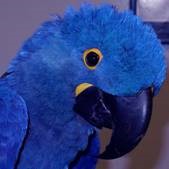
|
How are pet birds different than wild birds?
In contrast, our pet birds are kept largely in a cage that even when of generous proportions is unlikely to allow much exercise, they always have a ready source of food and water, and they are often housed alone. The wild bird that spends the greatest part of its day foraging is the same bird that is only provided limited socialization, no exercise and no foraging in captivity. Is it any wonder they pick? I love birds and intend to continue to share my home and my life with them. Therefore, I’m not advocating that birds should only be wild, but I am advocating that if we keep birds as pets than we must find the best way to make their lives as full and rich as their wild counterparts and as rich as they deserve.
|
|
|
Why does it matter how the chicks are raised?
Our pet birds are usually removed from their parents and or flock at a very young age or even when an egg. Their socialization from this point on is largely dependent on the care and knowledge of the breeder who must take over the role of flock and parents. Too many times the pet bird is raised alone and never allowed to learn correct parrot social behavior from clutch mates. Often the chick is adopted out prior to even weaning and many times the chick’s wings are cut prior to the first flight further restricting the physical, emotional, and mental development of the bird. Please understand, I do believe that pet parrots should be hand-raised, because I find it senseless for a being that is going to live in our homes for decades to live frightened of their caretakers. However, I also believe the way in which the chick is raised is vitally important to later behavioral development. Ideally, clutches of chicks should be raised together in a social group during and beyond the time they fledge. Allowing the chick to fledge and safely learn to fly is important for muscular and mental development. I believe that chicks that have learned to fly are more confident adults. I don’t however believe that all pet birds should be left flighted. The decision to trim the wings is largely dependent on the type of home the bird will live in. Hundreds of loved companion birds are lost every year due to an unexpected and inadvertent escape. While in some homes a flighted bird can be safely kept, in most homes it is best to slowly and progressively trim the wings of the fledged chick to the point at which flight and escape is limited.
Okay, so what is foraging and why is it important?
Foraging in the classic sense is the time in which a bird spends its day flying to and looking for food. Little of its time is spent in actual eating and much of the time is spent in the process of looking for the food. Foraging is a great way to stimulate the parrot’s mind and also encourage more movement and exercise.
|
So, how can a caged pet bird forage?
It is important to note that foraging must be taught to most of our pet birds and advanced foragers take months to develop and not days. Teaching a caged bird to forage involves a series of very simple changes to the bird’s cage and or free standing tree. Keep using the bowl in which the bird was typically fed, but don’t fill it to overflowing, put in just enough food for the day, and don’t put the most favored treats in the bowl. Now add several smaller foraging bowls all over the cage. Place these small bowls in the cage such that the bird must fully traverse its cage to get to all the bowls. Now place only a very small amount of a favorite treat in each of these bowls. It is important that the bird not reach the first bowl and eat its entire daily ration. We want to encourage the bird to move to and explore all the bowls. At this point you are already providing the bird with more exercise than our formally sedentary parrot who sits on its one favorite perch all day. When the bird has mastered finding treats in all the little bowls, begin to add a small piece of paper on top of each bowl so that the bird must push it off to get to the treat. Advance from here to taping the paper on the bowl so the parrot must chew through the paper to get the treat. Some retail foraging bowls come with lids that can be placed tightly so that the bird must work out how to undo the lid to get the treat. The idea being that as the bird masters each stage the foraging is made a little more physically and mentally demanding. Many excellent foraging type toys can be purchased from retail stores such as www.birdsjustwannahavefun.com, but toys can also be easily and inexpensively made at home.
|
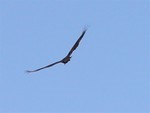
|
- Paper cups make a great foraging device. Use small paper cups and place a small treat in the cup, wad the cup into a ball and place in the cage or on the tree. The parrot must chew through the cup to get the treat. Advanced stages of this include placing a tie around the cup and suspending it from the tree so that the bird must pull the cup up by the tie to allow access for chewing.
- Tamale wraps can be used to make a great hidden treat. Again, place only a small amount of treat in the corn husk and wrap until fully covered and tie closed. Then allow the parrot to chew the tamale until the treat is revealed. Commercial type piñatas are available from retailers and serve much the same purpose as the tamale wrap, but come in interesting shapes and colors.
- Cardboard rolls are another easy foraging toy. The roll should be appropriately sized so that the bird can easily pick the roll up in its hand and chew out the treat that is hidden inside. Also, thicker cardboard is better as it requires more time for the bird to get the treat out. Many commercial products are available and now come in various colors and sizes.
- Paper can be weaved in the cage bars
- Adding machine tape can be hung on a perch
|
|
|
When your bird has become a master forager you can start to vary the routine somewhat and place a large variety of foraging toys in the cage. Some of the toys are now empty, some are filled with actual toys, and some are filled with small treats. You can also introduce some of the acrylic type toys that require an action such as opening a drawer, turning a wheel, or lifting a lid to get to the treat. A few of the better toy retailers include birdsjustwannahavefun, The Bird Brain, and Parrot island which makes a variety of treasure chests with various toys to fill them with.
The result?
So, as a result of these small changes you have implemented you will have a more physically, emotionally, and mentally fit companion bird with which to enjoy your life. The bird has gone from spending its day plucking out feathers and sitting on one perch to roaming all over the cage and discovering many yummy and interesting treats in its now much more exciting world
Acknowledgements
The photos used in this article are a combination of patient photos, my own birds and wildlife photos that I’ve taken in AZ and IA. Much of my own education has been through extensive reading on just about anything involving bird behavior. I’ve learned greatly from the published materials of Dr. Echols whose work has contributed greatly to the well being of captive birds world wide. I’ve gathered foraging & behavior information from various journal articles involving avian behavior, the Association of Avian Veterinarians Conference 2006-2009, Exotic DVM, and Captive Foraging DVD . Most importantly, keeping and raising birds throughout my life has provided me with unlimited opportunities for learning. My love and awe of birds is largely what lead me to become a veterinarian and the care I’ve provided my birds has been paid back a thousand fold with the knowledge they have shared with me, allowing me to utilize that knowledge repeatedly when caring for my patients. I thank them all
|
|
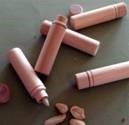
|
Recognizing A Sick Bird
An important thing to realize is that even the tamest and most loving of pet will excel at hiding or masking any sign on illness often until too ill to pretend. Therefore, it is our job as care takers of these wonderful creatures to be very in tune to the slightest of changes in our pets. Often times an owner will often just feel that something is not the same about their pet but may not be able to pinpoint any one thing. Please may attention to your instincts and have the bird examined by your veterinarian if you feel something is awry.
Fluffed:
So we’ve established that birds attempt to hide illness but they will still give subtle clues to the attentive owner. Most commonly a bird this is not feeling well is just less active and will spend more time on a perch sitting quietly fluffed up. If the bird is also weak you may notice that the bird is not resting with one leg tucked up to the body or you may notice the bird wobble or rock with resperations. An extremely weak bird will no longer perch but rather will sit on the bottom of the cage.
Feces:
Another early sign of illness is a change in the character or production of feces. Bird dropping are composed of
- urine is the watery ring
- urates are the white matter
- feces are the green matter
Any changes in any of these components can signify disease.
Appetite:
You may notice an increase or decrease in the amount or type of food ingested. For seed eaters it is important to pay close attention to the seeds. Occasionally a sick bird will appear to be eating but when the seeds are examined closely no shelled or cracked seeks are found. Also, pay attention to drinking as either increased or decreased water consumption may indicate a problem.
Palpation:
I highly recommend handling your birds on a daily basis not only for their enrichment but also to detect signs of disease early. Often the only way to determine that is bird is becoming thin is to feel it, the feathers hide too much! Additionally, when petting a bird you make notices massed, abnormal or missing feathers, abnormal breathing or diarrhea staining on vent, and even a weakened grasp to feet. So the take away message here is to pay attention to your instincts and to react quickly to prevent disaster.
|
|
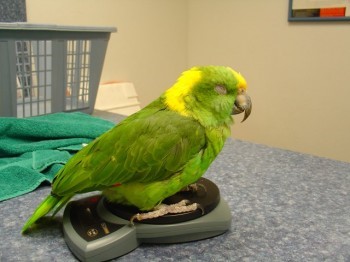
|
INJURED BIRD CARE
The key here is to follow the advice of your veterinarian and to reduce any and all stress to your recovering bird. Some things to pay close attention to are
1. PROVIDE WARMTH:
Ill birds will sit with their feathers fluffed in an attempt to conserve heat. The effort to conserve heat places an additional burden on the already debilitated bird. Your veterinarian will determine if your bird requires hospitalization, but if home care is acceptable, I recommend creating a tent to keep your bird warm. A birds natural temperature is much higher then ours at anywhere from 103F-106F. Therefore, what often feel warm to us can be chilly to them and this is particularly true in sick birds. A simple way of providing heat is to cover 1/2 of the cage with a blanket and place a heat lamp on the other side as a heat source. Generally speaking we keep our sick birds at environmental temperatures ranging form 85-95F. This will vary greatly with the individual bird so it is important to monitor your pet to ensure that you are providing the correct temperature and of course seek your veterinarian’s advice. A bird that is too hot will have very sleek feathers held tightly to the body, will hold its wings (shoulders) slightly away from its body and may pant. If you see any of these signs your bird is much too warm and the environmental temperature should be reduced accordingly. For night warmth I recommend using a red light. Ill birds, just like ill people, require rest and if kept under bright lights all night they will become sleep deprived. Also, during the day it is important to provide light so that they may be encouraged to eat and can be monitored. Therefore, the entire cage should never be covered during the day. I don’t recommend heating pads because it is very difficult to regulate the temperature. If a bird is not perching and sitting directly on the pad they can easily become overheated or burned. And in my experience baby bird that are raised on heating pad quickly become dehydrated and again are subject to burns.
2. STRESS REDUCTION:
Debilitated birds must be kept in a stress free situation. Often what appears normal to us can cause stress in our feathered friends. I suggest taking a close look at your bird’s environment with a critical eye to determine what may be stress factors. Some common one include, the bird in the center of house traffic with no chance to rest, cigarette smoke or aerosols in the birds environment, lack of darkness/sleep time at night, other pets, small children, too much visual stimuli (cage directly in front of a window), competition from cage mates, too much handling, poor nutrition and temperature extremes (such as birds kept in kitchens). I recommend that sick birds be left in their cage and allowed to calmly recuperate. Think of this as bed rest for your pet! Too much handling can stress the bird and will require the bird to use additional calories. If the bird is housed with other birds, it is usually best to remove the bird to a single cage. Some birds can become too stressed when separated from the colony so you should seek your veterinarian’s advice on how to cage your sick pet. However, generally removing the bird from the group will reduce the stress of competition for nutrition and allow for medicating easily and better monitoring. Of course, if infectious disease is suspected, then the pet must be moved into an isolation cage and at least a separate room – preferably a separate house with no other birds.
3. ENSURE ADEQUATE NUTRITION:
If your doctor made dietary recommendations, now is not the time to implement change. Changes in the type of diet will cause enormous stress to your bird and should be started when the bird has recovered. Always discuss how and when to made dietary changes with your pet’s doctor. Generally, I recommend offering all the bird’s favorite foods during illness because many ill birds become anorexic and can be lost due to starvation. If your bird is a seed eater and not currently eating, try placing millets sprays in the cage which most birds enjoy. The important thing to remember is that it has taken months to years for the bird to become malnourished and this cannot be corrected in a day or as week. Slow changes are essential for the ill bird. If you are unable to get your pet to eat he/she should be hospitalized for gavage feeding and further care. Birds have a high metabolic rate and can quickly starve. Thus, a pet bird that stops eating should always be assumed to be critically ill, certainly the potential for fatality is present. Lastly, if your bird is a hand reared baby and is not eating due to illness, you can often revert them back to hand feeding (syringe feeding) during the convalescent period. A good hand rearing formula should be used. The formula should be mixed with hot water as directed on the bag and offered to the bird. Do not force the bird to eat. Pet owners should never force feed their birds. A bird can easily aspirate (inhale food) and develop pneumonia and force-feeding causes enormous stress to your bird. Reverting to hand feeding is only of use for those birds that willingly accept feeding from the syringe. Also, if hand feeding, the formula must be warmed correctly (follow the advice on the formula bag and that of your veterinarian to avoid food burns from too hot formula and crop stasis for formula fed at too cool a temperature.
4.MEDICATING:
Routes:
- Injectable
- In water or Food
- Topical
- Oral
I prefer not to medicate in the pet’s water or the food. Medication given in this way often causes a change in the taste and can potential cause the bird to reduce their food and water intake. Thus, in my opinion the best routes are injectable and oral. Topical medication often is not of use to the pet and will cause oily feathers.
Prior to taking your bird home – You should be shown how to appropriately medicate your bird by the doctor or technician. Briefly, the patient should be held in an upright position and the syringe containing the medication should be gently introduced from the left side of the mouth and angled to the right side. Most birds will attempt to bite the syringe allowing it to be easily introduced into the oral cavity. Slowly depress the plunger on the syringe to dispense the medications into the lower portion of the beak. If the pet struggles while medication stop for a few moments and then try again. You should advise your veterinarian if you are unable to medicate your pet. Medication can be mixed with a flavoring agent (FlavorX), which will help to reduce some resistance. Occasionally, depending on the reason for treatment, your doctor may be able to give a long acting injection in place of oral medication but this has limited uses and thus is not available for every pet.
5. RECHECK EXAMINATIONS:
As soon as illness was detected in your pet he/she was taken to the veterinarian for a through physical examination and work-up. Unfortunately, many people will see that their pet is improving and don’t realize that a follow-up exam is necessary. I always suggest rechecking the patient at variable intervals depending on the state of debilitation. The recheck exam allows me to assess the patient’s response to treatment and the owner’s compliance with instructions. Many times in the course of treating an exotic pet the treatment must be altered somewhat to ensure the best response. These rechecks are also used as a ways to reinforcing the changes the bird requires to remain healthy. Additionally, lab values can be recheck to ensure that the patient is truly recovering and not just feeling well enough again to resume hiding any weakness. I can’t stress the importance of this follow up enough, it is extremely important to the health of your bird.
|
|
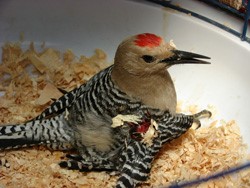
|
Common Medical Problems:
1. Malnutrition:
We commonly see malnutrition in birds. The cause is not the lack of food but rather years of feeding an incomplete and inadequate diet of seeds only. Yes, birds can live on seeds alone, but most experts now agree that their lives are shortened due to the chronic affects of malnutrition. The idea being that if you feed your bird better it will live a longer and healthier life. So what is a better diet? I don’t believe that there is only one answer to this question, partly because different types of birds will require different types of food, but also because we are still learning how to best feed our pet birds. However, there are some basics that you can utilize in the choice diet for your bird.
- A pellet-based diet is going to be more complete and balanced then a seed only diet.
- Veggies are good – you usually can’t go wrong by feeding your bird fresh vegetables daily. Typically, I advise my clients to convert their birds over to a good quality pellet diet, and to offer a mixture of leafy green and yellow veggies every day.
- Fruits are considered treats and should only be given in moderation.
- Avoid feeding any pits to birds (avocados can be toxic) and spinach should only be fed occasionally.
General Recommendation:
In general you need to provide a large variety of fresh food for your bird. Typically I recommend a core diet of an organic and color free parrot pellet. A large variety of fresh vegetables should be provided for both nutrition and mental stimulation. A small amount of seeds can be provided as a treat. Seeds should be clean and fresh. Sprouted seeds can also be offered and are a good way of introducing greens to the stubborn eater.
- Macaws: Again, variety will occur with the individual types of macaws. However, in general macaws require a higher fat content in their diet which can be provided with some of the large nuts as a part of their regular diet.
- African Greys: Are often subject to calcium deficiency and will require higher calcium content in their diet then other birds. The best way to provide this is by providing calcium rich foods such as cheeses and yogurt in moderation. Almonds are also a good source of calcium for birds.
- Eclectus: Often require more vitamin A in their diet than other birds, but you must be very careful with supplements because it is easy to create Vitamin A toxicity. Again, providing natural sources of Vitamin A is best. Feed leafy green and yellow veggies daily. Sweet potatoes are also a source of Vitamin A that many birds enjoy.
- Small Birds: Budgies & Cockatiels: These guys are my exception to the rule of pellets. In general I like to place my avian patients on a complete balanced pellet, but for budgies and cockatiels I recommend that the pellets be no more than 50% of their diet with fresh/clean seeds offered daily and of course fresh veggies.
Foods to Feed Only in Moderation:
(1)Those veggies containing a high amount of oxalates. Some common examples include: spinach, chard, and bok choy.
(2)Fruits, which can provide too much sugar in the bird’s diet.
(3)Diets that are based 100% on cooked beans calcium injections, medications to help the uterus contract and if all else fails may need to collapse the egg and remove it piece by piece. Some ways of preventing egg binding are to have your bird on a good diet, allow activity to provide good muscle tone, and prevent constant laying with breaks during the breeding cycle.
2. Feather Problems:
The most common feather problem is feather picking as discussed above. However, diseases can occur that will result in abnormal feather formation or growth. Viruses such as Psittacine Beak and Feather Disease and Polyoma Virus can often cause abnormal feather growth or feather loss. Feather cysts or ingrown feathers can occur and are common in some birds such as canaries. Changes in feather color can indicate organ disease such as yellowing which can indicate liver disease. Lastly, stress and malnutrition can both cause abnormal feather growth, delayed molt cycles and stress bars or weak points to the feather. So if a change is noted in the feather color, character or quantity the bird may have a disease condition.
3. Organ Disease
Birds like dogs, cats and indeed humans are susceptible to organ infection, inflammation, cancer and failure. The three most common organs involved include the liver, kidneys and gastrointestinal tract.
- Liver disease can be from infection or toxins and is also often related to chronic malnutrition. That is, a long term diet devoid of balanced nutrients can lead to liver disease such as hepatic lipidosis (fatty liver disease). The best way to avoid liver problems is to feed a very balanced diet.
- Kidney disease can be caused by a variety of factors like liver disease but again malnutrition may often play a role. For kidney health ensure a balanced diet, avoid over supplementing vitamins and minerals and provide plenty of fresh clean water to keep your bird well hydrated.
- Gastrointestinal disease can involve problems anywhere from the mouth through the cloaca. Common problems include crop burn and injury in chicks, foreign body ingestion, toxins, viral infection, bacterial and yeast overgrowth. Pay close attention to your pet’s normal weight and food intake will allow you to identify a GI problem early.
4. Infectious Disease:
- Infectious disease includes parasites, fungus/yeast, bacteria, and viruses.
- Internal parasitic infections: are uncommon in birds raised and kept indoors but will be seen in aviary birds especially if kept on dirt flooring or cages with poor cleaning/hygiene. Signs may range from malnutrition and diarrhea to the absence of any symptoms. Fungal diseases: are common in birds housed in unsanitary conditions, those in more humid parts of the U.S. and those housed with poor ventilation.
- Fungal infections can be GI such as megabacteria, often seen in budgies as chronic wasting, or more commonly may involve the respiratory tract and cause wheezing or respiratory distress.
- Yeast: candidia is common in chick being handfed and is often related to overfeeding or feeding at improper temperatures. Yeast overgrowth may also be seen in birds on long term or numerous antibiotics. Common signs are regurgitation and weight loss, failure to thrive
5. Foot Trauma Commonly caused by other birds in the cage.
May be seen as wounds or bleeding on the toes. Additionally causes include constriction by material such as thread wrapping around the toes and causing necrosis and blackening. And trauma in the flighted bird allowed lose in the house – often perch on a door that is closed or landing on a hot surface.
6. Reproductive Disease
As with dogs and cats, reproductive disease in birds can take a variety of forms including dystocia (stuck egg or egg bound), ectopic egg laying, oviduct infection or rupture, hormonal problems and more. Signs of reproductive behavior can range from aggression to a weak and lethargic bird. The egg bound bird will often, but not always have a history of egg laying. She will attempt to pass the egg over many hours to days. The longer the egg remains the more gravely ill she will become. Illness develops from dehydration, malnutrition and pressure of egg on kidney’s. Typically the bird will be found sitting on the bottom of the cage often very lethargic and intermittent straining may be noted by the owner. The vent will often have feces present and an abdominal bulge may be noted. Care should be taken on handling the dystocia bird so as to not break the egg in her oviduct. The bird should be taken to your veterinarian as soon as a problem is noticed. Veterinary therapy will include hydration, lubrication, calcium injection and possible hormones. As a last resort surgery is performed to collapse the egg from within allowing delivery.
Constant egg laying:
Another common reproductive problem in pet birds and cockatiels see to be notorious for this condition. Many pet birds will lay eggs throughout the year with or without a mate. Unfortunately, owners often remove the eggs from the cage and this forces the bird to lay a new clutch. Repeated egg laying is very hard on the hen and can result in very low calcium and egg binding, among other problems. If you have a chronic egg layer I recommend purchasing a few plastic egg of the appropriate size and once the bird has laid her clutch (usually a set number of eggs each clutch) you should replace her eggs with the plastic and allow her to sit on the fake eggs.
This does two things
- prevents for from laying a new clutch for a short time and
- prevents fertile eggs (if a mate is present) from being hatched and causing a further drain on the hen. I also suggest attempting to reduce the hen’s daylight hours to mimic a winter environment in an attempt to bring her out of the breeding season. And of course, it is vital that a chronic egg layer be on an excellent diet that is rich in calcium and sunlight/vitamin D.
Occasionally, a bird will have internal problems associated with egg laying. This can include problems such as an ectopically laid egg and cystic follicles. In addition to a bird that is feeling and acting sick, you may notice fluid build up in the birds abdomen. Such birds should be taken to a veterinarian immediately.
Behavioral issues were discussed above. If behavioral problem persist it may be beneficial to contact a recognized avian behaviorist and of course consult with your veterinarian.
So, these are just a very small sampling of some of the medical and surgical conditions your veterinarian will see and treat on a regular basis. Please, if you are concerned your pet is showing signs of illness, have him examined by your avian veterinarian.
|
|
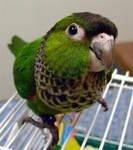
|
Converting Your Bird to A Pellet Diet:
Birds learn what to eat from their parent when they are very young. They are true mimic eaters learning what to eat in the wild by watching their parents and other flock members. This can result in some problem for us if the birds were not exposed to a variety of foods by the person rearing the chick. Many birds can be very stubborn about accepting a change in their diet and will actually starve to death because they don’t seem to realize that the new food is eatable. Therefore, any change in diet must be done with close supervision and monitoring or the bird’s weight.
1)Limit seeds to 2 timed meals daily: I like this method because if the owner is persistent it seems to always work. The idea is to take out all seeds and place fresh pellets in their normal food bowl. It is best to leave the pellets in for the first 1-2 hours every morning and then offer 15 minutes of their regular former diet so that they do not go hungry. Repeat this in the evening. The idea is to offer the pellets when the bird are most hungry but to starve the bird into eating
2) Choose a human grade bird pellet such as Harrison’s and allow the bird to see you eating the pellets. Birds learn by example and are likely to be interested in anything you show interest in. Do remember that birds and humans have different normal bacteria in their GI tracts do not offer food from your mouth.
3) Soak the pellets in sweetened juice or a favorite food to encourage eating based on flavor.
4) Make cornbread mix and place the old diet, veggies, and the new diet in the mix. Then feed birdie bread. Harrison’s now makes a powdered starter for birdie bread that I highly recommend.
5) Use a teacher bird. Similar to #2 this allows your bird to learn by example. Bird Booklet
|
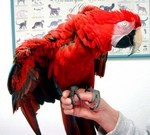 |
LINKS:
Behavior:
Liz Wilson a respected consultant on avian behavior: http://www3.upatsix.com/liz/bio.html
Good Bird Magazine, books by Good Bird Inc founder Barbara Heidenreich, DVD’s. workshops and consulting services. http://www.goodbirdinc.com
Association of Avian Veterinarians – Pet bird care http://www.aav.org/basic_care.htm
Parrot Problem Solving - https://www.parrotproblemsolving101.com/the-library
DIET:
Harrison’s Pelleted diet: http://www.harrisonsbirdfoods.com/
Harrison’s Bird Food – Caregiver Tips http://www.harrisonsbirdfoods.com/avian_caregiver/main.htm
MISC.
VSPN Page of Bird Links by Species http://www.vspn.org/LIBRARY/WWWDirectory/BirdSpecies.htm
Feather Picking Web site: http://www.featherpicking.com
Avian Web – bird diseases and more http://www.avianweb.com/diseases.htm
About.com – bird diseases http://exoticpets.about.com/cs/healthdiseases
Genetic Calculator for Bird Color Mutations //www.vin.com/WebLink.plx?URL=http://gencalc.rasek.biz
Avian Rescue http://www.avianrescue.org/bc-az.html
Bird Whisperer http://www.thebirdwhisperer.com
Clicking with Birds http://www.avitrain.com
Long Island Parrot Society http://www.liparrotsociety.org
NON-PSITTACINE TYPE BIRDS:
Poultry Page http://www.feathersite.com/Poultry/BRKPoultryPage.html
The Coop – chickens http://www.the-coop.org
|
|
|